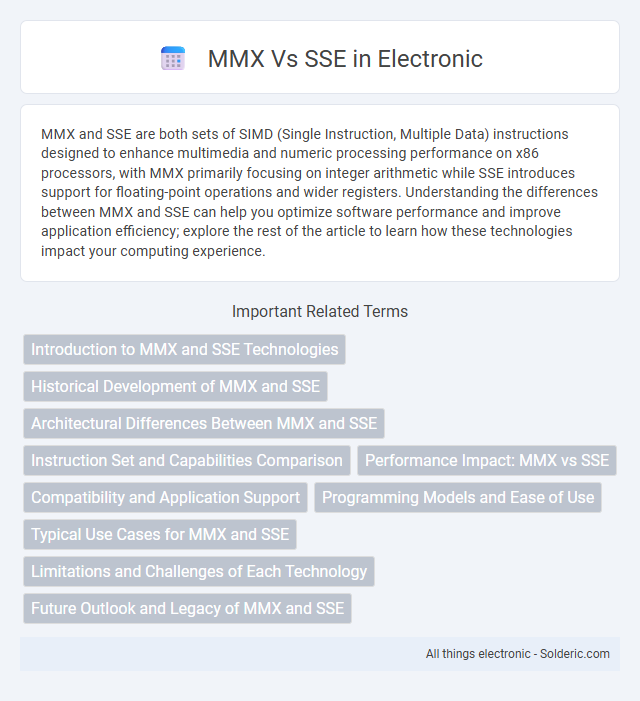MMX and SSE are both sets of SIMD (Single Instruction, Multiple Data) instructions designed to enhance multimedia and numeric processing performance on x86 processors, with MMX primarily focusing on integer arithmetic while SSE introduces support for floating-point operations and wider registers. Understanding the differences between MMX and SSE can help you optimize software performance and improve application efficiency; explore the rest of the article to learn how these technologies impact your computing experience.
Comparison Table
| Feature | MMX | SSE |
|---|---|---|
| Introduction Year | 1996 | 1999 |
| Developer | Intel | Intel |
| Register Size | 64-bit MMX registers | 128-bit XMM registers |
| Instruction Type | Integer SIMD | Floating-point SIMD + Integer |
| Data Types Supported | 8, 16, 32-bit integers | Single-precision floating point, 8, 16, 32-bit integers |
| Compatibility | Reuses FPU registers, can cause state conflicts | Separate registers, better for parallelism |
| Performance | Improves multimedia and integer operations | Enhanced multimedia, graphics, scientific computing |
| Legacy | Superseded by SSE | Foundation for SSE2 and later extensions |
Introduction to MMX and SSE Technologies
MMX and SSE are multimedia instruction set extensions introduced by Intel to enhance the performance of multimedia and communication tasks. MMX, launched in 1996, uses 64-bit registers to accelerate integer-based operations, while SSE, introduced in 1999, expands capabilities with 128-bit registers and support for floating-point calculations. Understanding these technologies helps you optimize processing efficiency in applications involving graphics, audio, and video.
Historical Development of MMX and SSE
MMX technology, introduced by Intel in 1997, marked the first significant step towards enhancing multimedia performance through SIMD (Single Instruction, Multiple Data) instructions on x86 processors. SSE (Streaming SIMD Extensions) followed in 1999 with the Pentium III, expanding on MMX by supporting floating-point operations and wider 128-bit registers, enabling more efficient processing of graphics, audio, and scientific applications. The evolution from MMX to SSE reflects a shift from integer-only operations to more versatile and powerful SIMD capabilities, driving performance improvements in modern computing tasks.
Architectural Differences Between MMX and SSE
MMX architecture introduced 57 new instructions primarily for integer operations using eight 64-bit registers shared with the floating-point unit, limiting parallelism and data versatility. SSE expanded the register set to eight 128-bit XMM registers, enabling both integer and floating-point packed data processing with improved SIMD capabilities. This architectural evolution in SSE provided greater parallelism, enhanced multimedia performance, and better support for complex mathematical computations compared to MMX.
Instruction Set and Capabilities Comparison
MMX uses 57 instructions primarily focused on integer SIMD operations suited for multimedia tasks, while SSE expands capabilities with 70+ instructions supporting floating-point SIMD operations for enhanced performance in graphics and scientific computations. SSE introduces 128-bit registers, doubling data throughput compared to MMX's 64-bit registers, enabling more efficient parallel processing. Your choice between MMX and SSE should consider the need for floating-point precision and broader instruction sets offered by SSE.
Performance Impact: MMX vs SSE
SSE (Streaming SIMD Extensions) delivers significantly better performance than MMX due to its wider registers and support for floating-point operations. MMX operates on 64-bit registers and is limited to integer data types, while SSE uses 128-bit XMM registers enabling simultaneous processing of more data elements and improved parallelism. Benchmark tests demonstrate that SSE accelerates multimedia and scientific computations by leveraging its advanced instruction set, resulting in higher throughput and lower latency compared to MMX.
Compatibility and Application Support
MMX instructions primarily target integer-based multimedia tasks and are supported on older x86 processors, ensuring compatibility with legacy software. SSE extends this by offering floating-point calculations and broader application support in modern multimedia, gaming, and scientific software. Many contemporary applications favor SSE due to its enhanced performance and wider instruction set, while MMX compatibility remains critical for running older, legacy programs.
Programming Models and Ease of Use
MMX uses a simpler programming model primarily focused on integer operations with limited registers, making it easier for basic multimedia tasks but less flexible for complex computations. SSE introduces a more advanced SIMD architecture with a wider set of floating-point and integer registers, enabling more versatile and powerful parallel processing while requiring deeper understanding and more complex coding. Your choice between MMX and SSE depends on the programming complexity you are willing to handle and the performance benefits needed for specific multimedia or scientific applications.
Typical Use Cases for MMX and SSE
MMX technology is primarily used for accelerating multimedia tasks like image processing, audio compression, and simple video encoding by utilizing 64-bit SIMD instructions. SSE extends these capabilities with 128-bit registers, enhancing performance in complex 3D graphics rendering, scientific simulations, and high-precision audio processing. Your software benefits more from SSE when handling intricate mathematical computations or applications requiring greater floating-point precision.
Limitations and Challenges of Each Technology
MMX technology is limited by its 64-bit registers, restricting the amount of data processed simultaneously and posing challenges for handling floating-point operations efficiently. SSE improves on this with 128-bit registers and better support for floating-point calculations, yet it can face compatibility issues with older software and requires more complex programming techniques. Understanding these limitations helps you optimize performance when choosing between MMX and SSE for multimedia and vector processing tasks.
Future Outlook and Legacy of MMX and SSE
MMX technology laid the foundation for multimedia processing by introducing SIMD (Single Instruction, Multiple Data) instructions that accelerated tasks like video encoding and image processing. SSE expanded upon MMX by offering wider registers, enhanced instruction sets, and improved floating-point performance, becoming a standard in modern CPUs and enabling more complex applications. Your choice of optimization should favor SSE and its successors due to their ongoing support, broader capabilities, and relevance in current and future software development.
MMX vs SSE Infographic

 solderic.com
solderic.com